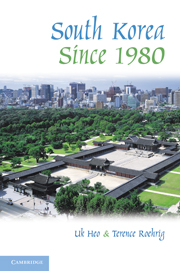Book contents
- Frontmatter
- Contents
- Dedication
- 1 Politics, Economics, and Foreign Relations before 1980
- 2 From Dictatorship to Democracy
- 3 Democratic Consolidation and Social Change
- 4 Economic Development and Financial Crisis
- 5 Economic Reform and the Korea–U.S. Free Trade Agreement
- 6 Inter-Korean Relations and the North Korean Nuclear Crisis
- 7 The South Korea–U.S. Alliance
- 8 South Korea and the Regional Powers
- Selected Bibliography
- Index
- References
1 - Politics, Economics, and Foreign Relations before 1980
Published online by Cambridge University Press: 05 June 2012
- Frontmatter
- Contents
- Dedication
- 1 Politics, Economics, and Foreign Relations before 1980
- 2 From Dictatorship to Democracy
- 3 Democratic Consolidation and Social Change
- 4 Economic Development and Financial Crisis
- 5 Economic Reform and the Korea–U.S. Free Trade Agreement
- 6 Inter-Korean Relations and the North Korean Nuclear Crisis
- 7 The South Korea–U.S. Alliance
- 8 South Korea and the Regional Powers
- Selected Bibliography
- Index
- References
Summary
As Park Chung-hee sat down for dinner on October 26, 1979, with some of his closest advisors, he was facing one of his most difficult decisions as president of South Korea. Protests calling for political reform and democracy were intensifying throughout the country, and many feared the demonstrations would get out of control. Should the government crack down on the demonstrators or begin a process of bringing political change to the country? During dinner, a heated argument ensued during which Kim Jae-kyu, the head of the Korean Central Intelligence Agency (KCIA), received severe criticism from those in attendance for his handling of the demonstrations. Kim Jae-kyu stormed out of the room and returned after a few minutes with a .38 revolver in his pocket, having told his own security detail to shoot President Park's guards if shots rang out. Suddenly Kim Jae-kyu rose from his place, pointed the gun at Cha Ji-chul, the head of Park's security guards, and shouted to Park, “How can you have such a miserable worm as your adviser?” Kim squeezed off two shots at close range, first at Cha Ji-chul and then at Park himself, before the gun jammed. With Park lying wounded on the floor, Kim grabbed a gun from one of his men and shot Park again, finishing the job. Cha Ji-chul ran away to another room, but Kim chased him down and shot him to death.
- Type
- Chapter
- Information
- South Korea since 1980 , pp. 1 - 27Publisher: Cambridge University PressPrint publication year: 2010



